Opening ceremony in Gyor, the Italian flag flies: at the start of the XIV edition of the EYOF
- EUROPEAN YOUTH OLYMPIC FESTIVAL
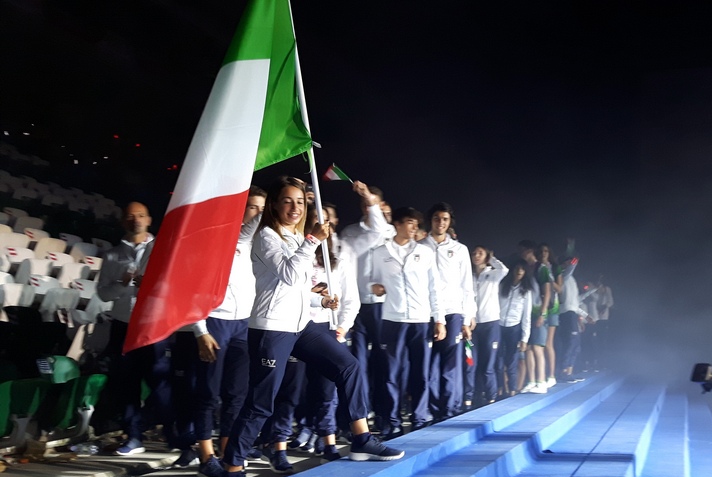
Announcement from the National Council
- CONI
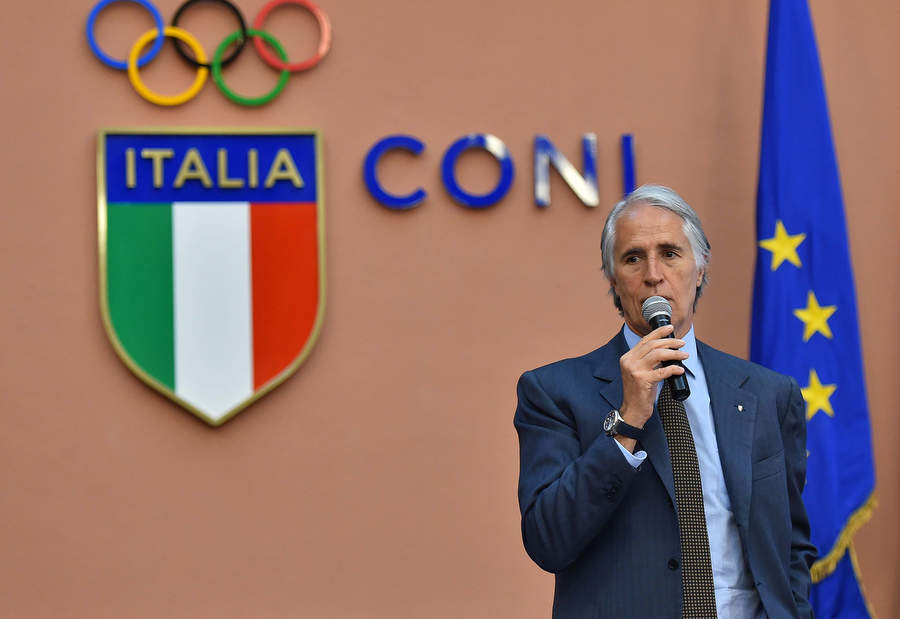 The 254th CONI National Council met this afternoon at 3:00 PM in the Foro Italico Salone d'Onore to discuss the following order of the day:
The 254th CONI National Council met this afternoon at 3:00 PM in the Foro Italico Salone d'Onore to discuss the following order of the day:Six candidates approved for IOC Athletes’ Commission elections in PyeongChang
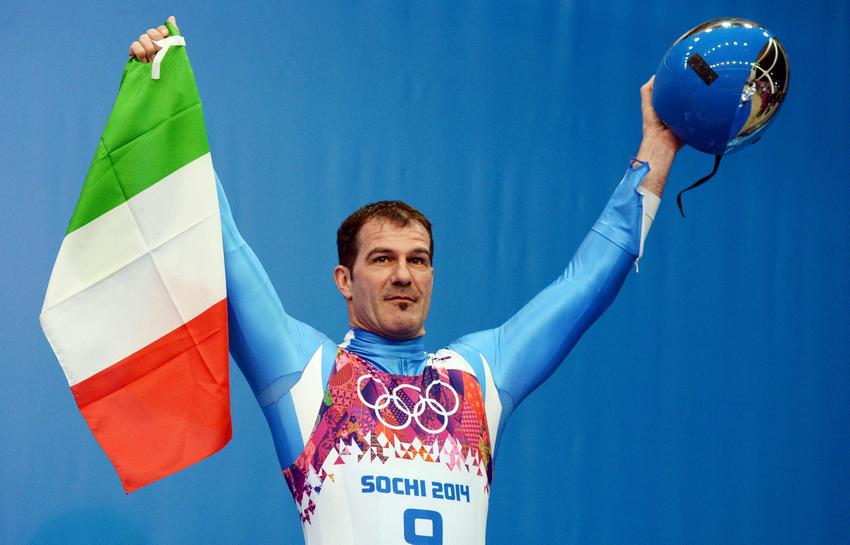 The International Olympic Committee (IOC) Executive Board today approved the candidatures of six winter sports athletes for the IOC Athletes’ Commission elections, which will be held during the Olympic Winter Games PyeongChang 2018 next February.
The International Olympic Committee (IOC) Executive Board today approved the candidatures of six winter sports athletes for the IOC Athletes’ Commission elections, which will be held during the Olympic Winter Games PyeongChang 2018 next February.
Welcoming this approval, current Chair of the Commission Angela Ruggiero said: “I am delighted with the calibre of candidates running for a place in the IOC Athletes’ Commission. I have every confidence in each candidate to strongly represent athletes in the Olympic Movement and continue the excellent work of the IOC Athletes’ Commission to date. I wish all of them the best of luck, and urge all Olympians competing in PyeongChang next year to vote for the candidates they wish to represent them on the IOC.”
Nominated by their respective National Olympic Committees (NOCs), the candidates vying for two available positions originate from three continents and represent five different sports.
The candidates are: Astrid Uhrenholdt JACOBSEN (NOR) (skiing/cross-country); Ander MIRAMBELL (ESP) (skeleton); Kikkan RANDALL (USA) (skiing/cross-country); Emma TERHO (FIN) (ice hockey); Hong ZHANG (CHN) (skating/speed-skating); and Armin ZOEGGELER (ITA) (luge).
Two seats on the Commission will become available in 2018, with current Chair Angela Ruggiero and member Adam Pengilly finishing their terms of office next February. All athletes participating in the next Olympic Winter Games in PyeongChang will be eligible to vote for their preferred candidates. After approval by the IOC Session, the two elected Olympians will become IOC Members for an eight-year term.
Six representatives have been nominated by the IOC President to form the Election Committee to oversee the IOC Athletes’ Commission election. The Committee is composed of: Nicole Hoevertsz (Chair of the IOC Election Committee and representing the IOC Legal Affairs Commission); Pierre-Olivier Beckers-Vieujant (representing the IOC Ethics Commission); James Tomkins (representing the IOC Athletes’ Commission); Dagmawit Girmay Berhane (representing the IOC Members Election Commission); Ivo Ferriani (representing the Association of International Olympic Winter Federations (AIOWF)); and Mikaela Cojuangco Jaworski (representing ANOC). The Election Committee will be responsible for ensuring that the procedures and regulations are followed at all times as well as certifying the final vote count.
A joint meeting to discuss future strategies
Following the candidatures’ approval, the IOC Athletes’ Commission joined the Executive Board for a joint meeting in order to discuss the development and implementation of their future strategy.
“Our mission is to represent athletes within the Olympic Movement and support them to succeed on and off the field of play,” explains Angela Ruggiero. “Today, we discussed the key challenges of the Olympic Movement relating to athletes and highlighted the ways in which our strategy would help address these points. I look forward to building on this incredible momentum and maximising the positive impact we can make on behalf of athletes and the Olympic Movement”.
Throughout the strategy development process, the IOC Athletes’ Commission has engaged with a number of stakeholders and partners, including IOC leadership, International Federations and Continental Associations Athletes’ Commissions, to mention but a few. Vice-Chair of the IOC Athletes’ Commission Tony Estanguet said: “We recognise that the Olympic Movement is not free of challenges, and the IOC Athletes’ Commission has been, and continues to be, key to addressing issues such as doping”.
He added: “We are absolutely delighted to have the full support of the IOC President and IOC Executive Board, and very much recognise the fundamental role of the Olympic Movement stakeholders in the successful delivery of our strategy. We look forward to continuing our strong partnership and collaboration with all stakeholders to ensure that we can serve our peers in the best possible way”. The IOC Athletes’ Commission will finalise its strategy over the coming months, and it will be formally presented for approval by the IOC Executive Board this September.
An active Commission for and by athletes
Reflecting the Olympic Agenda 2020 aim of placing the athletes at the heart of the Olympic Movement and strengthening the support to athletes, the IOC Athletes’ Commission serves as a link between athletes and the IOC. The majority of members of the Commission are elected directly by Olympic athletes and act as the athletes’ representatives in the Olympic Movement. Members of the Commission are also present on the majority of IOC commissions, and the Chair serves on the IOC Executive Board as a full member.
The goal of the IOC Athletes’ Commission is to ensure that the athletes’ viewpoint remains at the heart of the Olympic Movement decisions. Additionally, an integral part of the work is to support athletes on and off the field of play and to promote the protection of clean sport.
The Commission members are also involved in many key IOC activities and fully integrated into the IOC decision-making process. This includes the process for evaluating Candidate Cities seeking to host the Olympic Games and the composition of the sports programme for the Games.
CONI and ActionAid together through Tokyo 2020
- MEMORANDUM SIGNED IN L'AQUILA
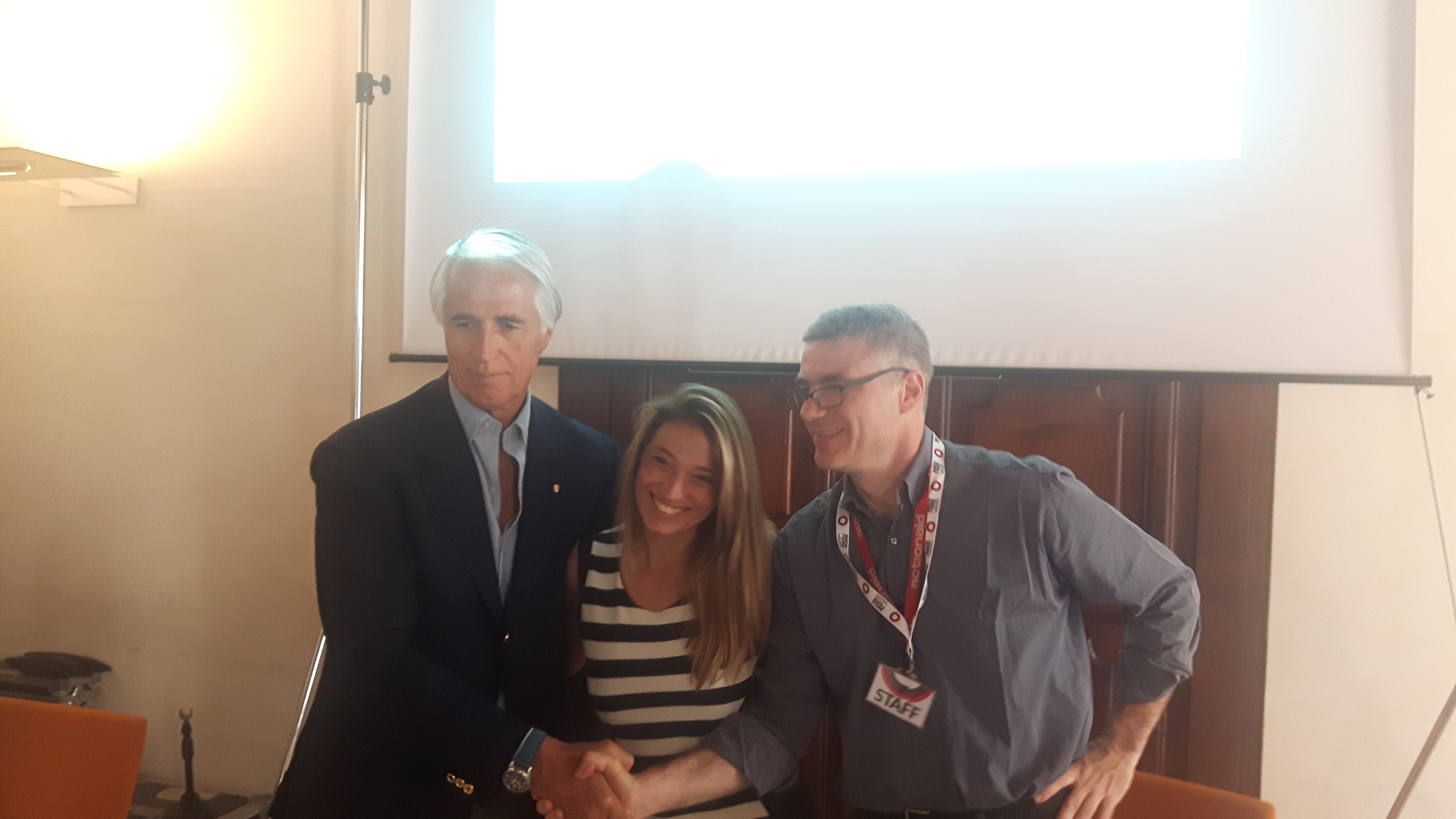
World is abuzz with activities as millions get active on Olympic Day
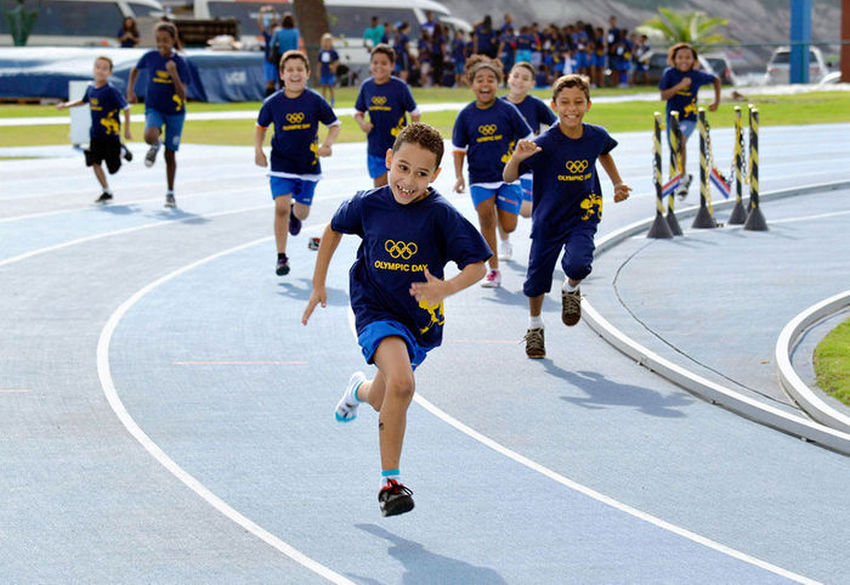 According to the World Health Organisation (WHO), globally, one in four adults are not active enough and more than 80 per cent of the world’s adolescent population is insufficiently physically active. In a bid to reverse that trend, the International Olympic Committee (IOC) called upon the Movement at large – from National Olympic Committees (NOCs), International and National Sports Federations to Organising Committees of Olympic Games and Youth Olympic Games, National Olympians Associations and Young Ambassadors – to help get the “couch potatoes off the couch”.
According to the World Health Organisation (WHO), globally, one in four adults are not active enough and more than 80 per cent of the world’s adolescent population is insufficiently physically active. In a bid to reverse that trend, the International Olympic Committee (IOC) called upon the Movement at large – from National Olympic Committees (NOCs), International and National Sports Federations to Organising Committees of Olympic Games and Youth Olympic Games, National Olympians Associations and Young Ambassadors – to help get the “couch potatoes off the couch”.
The result? Close to 6 million people of all ages and abilities have been joining the movement and taking part in Olympic fun runs and quizzes, trying new sports, competing in school tournaments, contributing to musical and arts exhibitions or chatting with champions. And there is more to come!
People in motion across the continents
From Albania to Antigua and Barbuda, Gambia to the Federated States of Micronesia, or Canada to Sri Lanka, 108 NOCs across all five continents have already heeded the IOC’s call to action. In collaboration with National Federations and local authorities and leveraging the power of their Olympians, many have or are staging educational, cultural and sporting activities in their territories to encourage their communities to be active and spread the Olympic values in the lead-up to and on Olympic Day. By the end of the year, this figure should rise to 142 NOCs.
The Serbian Olympic Committee, for instance, garnered the support of national Olympic champions and elite athletes to motivate the more than 3,000 participants taking part in the various races, from relays to family runs, in the capital city of Belgrade earlier this month. Similarly, the Slovenian NOC organised a mini Olympiad event in Ljubljana for local children to discover new sports with the help of its national sporting heroes. In Bhutan, the NOC mobilised national sports federations and several primary schools to engage nearly 1,500 students in an Olympic Day run, sports introductions, meet-n-greets with Bhutanese Olympians and learning the Olympic values. In turn, the Olympic Committee in Nepal kicked off a whole week of Olympic Day activities in which they expect 5,000 participants, including sportspersons and civil society members, to join.
In other parts of the world, such as Burkina Faso, Cameroon and Ethiopia, NOCs are celebrating Olympic Day by introducing local communities to new sports on the Olympic programme, such as baseball and softball, or to more traditional sporting activities such as tugs of war. They are also using this platform to raise awareness of important local environmental and social issues, and the role that sport can play to face some of these challenges.
Our Young Ambassadors have also been showing their support for Olympic Day. Colombian Young Change-Maker (formerly known as Young Ambassadors) Juan Sanchez decided to focus his attention on seniors and pensioners in his hometown of Bogotá. Concerned by the lack of opportunities they have to exercise, the Young Change-Maker organised yoga and Zumba classes. Met with great enthusiasm and positive results, the 25-year-old is already working on follow-up activities in order to ensure there is greater movement amongst this elderly community.
Athletes driving inspiration on #OlympicDay
In addition to the multitude of activities taking place across the continents, the Olympic Movement’s digital platforms have all been in Olympic Day mode in order to reach out to its millions of fans. Olympic medallists Yuna Kim, Justin Rose, Mariana Pajon, Martin Fourcade, Pusarla Venkata Sindhu and Simone Biles along with football legends Ronaldo and Carles Puyol are among those who have already been busy posting and inspiring their fans to follow their lead and share their photos and videos of their #OlympicDay sporting moments on social media.
With just under a year to go until the next Olympic Winter Games in PyeongChang, winter athletes are also making the most of Olympic Day to train for their qualification events and build excitement for what’s to come next February. For instance, German luger and Olympic champion Felix Loch joined forces with the International Luge Federation to teach kids in his country how to slide.
To see how the world is getting active for #OlympicDay, visit: https://olympicdaysocial.olympic.org
Press release from the National Council
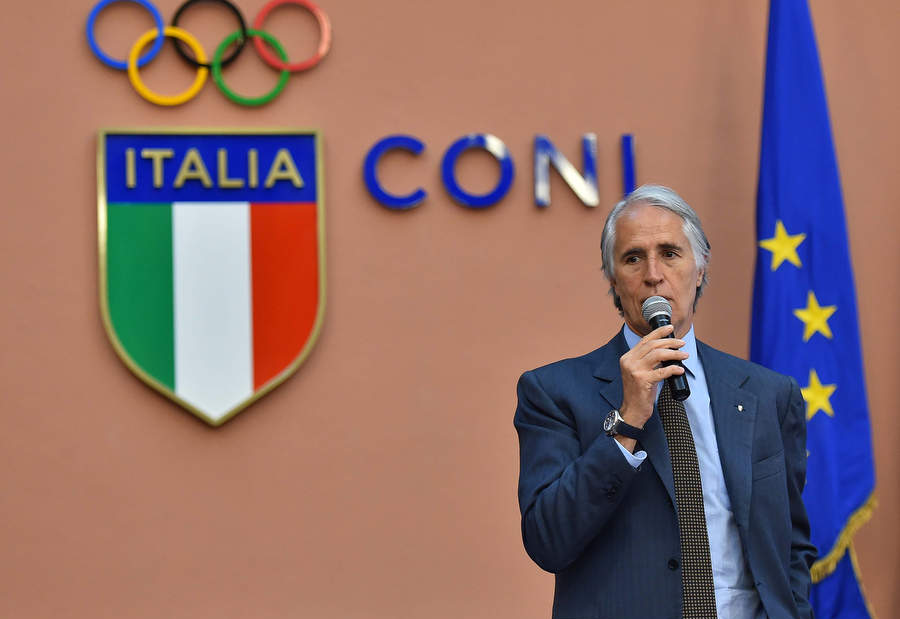 The 253rd INOC National Council met this morning at 10.00am in the Hall of Honour at the Foro Italico to discuss the following agenda:
The 253rd INOC National Council met this morning at 10.00am in the Hall of Honour at the Foro Italico to discuss the following agenda:
1) Approval of minutes from meetings of 10 and 11 May 2017: unanimously approved.
2) President’s announcements: Malagò opened proceedings by commemorating the figures of the sporting world that we have lost in the past month, contextually emphasising the important results achieved by the Italian national teams during that period. The President then celebrated the unforgettable day we experienced yesterday, with the first, historic visit by a head of state to INOC, thanks to the affinity shown once again by Mattarella. The event, planned for the last 2 years, managed to involve all the major players in the sporting world, and the President of the Republic reiterated the importance of the movement for the growth of the country, as a fantastic social and economic lever, a reflection of Italy, saying that he was proud of the excellence that the movement can express. The day of celebration of the presence of, among others, Minister of Sport Luca Lotti, also confirmed the generosity of relations with the institutions, further enhanced by the announcement of an additional fund of 100 million euros for the “Sports and Suburbs” fund. On the subject of relations with the government, there was also mention of the definition of the structure of the Cortina 2021 Committee with the investiture of Alessandro Benetton, according to a shared process to ensure significant impact.
Malagò then announced to the Council the co-opting of Giovanni Pellielo as Athlete Representative, after the resignation of Raffaello Leonardo, then going on to address the issue of the relationship between INOC – through INOC Services – and the Federations, thanks to the joint ventures related to international events, advocating the possibility of widening the range of synergies with other companies to organise new events. Regarding Tokyo 2020, there was discussion of the important changes introduced by the IOC at the Olympic programme level, with the revolution regarding the entry of new specialities and formats - in many cases referring to mixed-gender events - without altering the number of participating athletes, thereby undermining the share of the existing disciplines.
Federations section: after the appointment of the Executive – now ratified by the Council - of Alberto Miglietta as Commissioner of the Italian Canoe Kayak Federation – the President informed the assembly of the developments relating to the IAeC - the Federation overseen by the Ministry of Infrastructure and Transport – that on Saturday reelected Leoni as President, despite his having been suspended by the Guarantor of the Code of Conduct in Sports. In terms of nominations, in addition to Zoeggeler vying to join the IOC Athletes Commission, the process of Milan’s bid to host the 2019 session of the International Olympic Committee was formally completed, and the assembly was reminded that in July – in Lausanne – the possibility of assigning the 2024 and 2028 Summer Games simultaneously will be discussed. Malagò then talked about the establishment of the working group for the speech on the uniformity of rules and regulations, under the constant supervision of the Supervisory College, and the working group for Sports Justice, also informing the establishment of the new fiscal commission. The President closed his speech by conveying the regards of the head of the IOC, Thomas Bach, to the National Council.
There were speeches on the report and on other issues from: Giovanni Petrucci (Basketball), Mario Pescante (IOC Member), Sabatino Aracu (Wheeled Sports), Franco Chimenti (Golf).
3) F.S.N .- D.S.A. - E.P.S. activities: Administration by an external commissioner of the Italian Canoe Kayak Federation: the appointment of Alberto Miglietta was ratified. Having nothing else to pass, the Council closed proceedings at 11.35.
Mattarella embraces the world of sport: exciting ceremony at the CONI
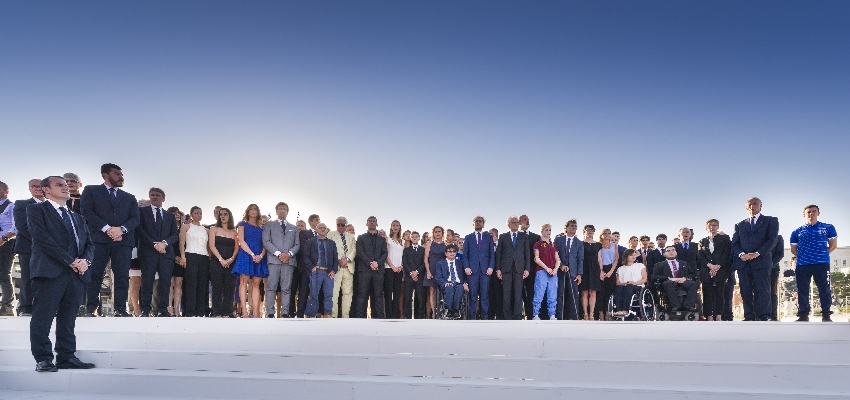 The President of the Italian Republic, Sergio Mattarella, today visited the CONI headquarters for a meeting with the world of sport in the fascinating and suggestive setting created in the area in front of the Stadio dei Marmi. This was a historical “first”: no Head of State had in fact ever before visited the headquarters of the Italian National Olympic Committee.
The President of the Italian Republic, Sergio Mattarella, today visited the CONI headquarters for a meeting with the world of sport in the fascinating and suggestive setting created in the area in front of the Stadio dei Marmi. This was a historical “first”: no Head of State had in fact ever before visited the headquarters of the Italian National Olympic Committee.
Playing host was the President of the CONI, Giovanni Malagò who welcomes the Head of State together with the Minister of Sport, Luca Lotti, and the President of the Italian Paralympics Committee, Luca Pancalli.
Taking part in the event were the presidents of the National Sports and Paralympics Federations, of the Associated Sports Disciplines, of the Associazioni Benemerite (Praiseworthy Associations), of the Sports Promotion Bodies, of the Regional Committees, and numerous athletes of both the present and past.
Participants included Olympic athletes Elia Viviani (Cycling) and Niccolo Campriani (shooting) Diana Bacosi (Shooting), Fabrizio Donato (Athletichs), Matteo Castaldo (Rowing), Marta Pagnini (Ggymnastic), Luigi Busà (Karate), Gabriele Detti (Swimming), Francesca Piccinini (Volleyball), Riccardo De Luca (Pentathlon), Mirco Scarantino (Weightlifting), Margherita Granbassi (Fencing), Valentina Marchei (Ice Sports), Francesca Lollobrigida (Roller Sports), Filippo Volandri (Tennis), Claudia Mandia (Archery), Alessandro Fabian (Triathlon), Flavia Tartaglini (Sailing), Veronica Yoko Plebani (Canoe Kayak), Anika Niederwieser (Handball), Yuri Farneti (Squash), Alessia Mesiano (Boxing), Luca Marziani (Equestrian Sports), Giacomo Redondi (motorcycling), Alberino Pascale (Federation of Hunting and Sporting Weapons), Alessia Zecchini (Federation of Sport Fishing and Underwater), Gianluca Formicone (Bowling Federation), Rosario Maddaloni (Badminton), Letizia Ingrosso (Dance Sport), Erika Piancastelli (Basebal Softball), Renato Paratore (Golf), Chiara Colantoni (Table Tennis), Davide Spinosa (Taekwondo), Dalila Mirabella (Hockey), Thomas Degasperi (Ski and Wakeboarding Federation), Sara Gama (Football), Fabio Andolfi (Automobil Club), Giorgio Bracci (Rugby), Renato Molinari (Powerboat), Alex Righetti (Basket), Sofia Goggia (Winter Sports Federation), a group of athletes from the Associated Sports Disciplines, and representatives of Athletes and Coaches belonging to the National Council.
Other participants included Raffaello Leonardo (Rowing), Daniele Lupo (Volleyball), Clemente Russo (Boxing) and a delegation of Walk of Fame athletes: Lea Pericoli, Nino Benvenuti, Giacomo Agostini, Gianni Rivera, Dino Meneghin, Gabriella Dorio, Patrizio Oliva, Ezio Gamba, Mauro Numa, Carmine Abbagnale, Giuseppe Abbagnale, Giuseppe Di Capua, Alessandro Campagna, Josefa Idem, Novella Calligaris, Giorgio Lamberti, Jury Chechi, Stefano Baldini, Domenico Fioravanti, Maurizio Damilano, Armin Zoeggeler, Paola Pigni, Nicola Pietrangeli and Abdon Pamich and for the Paralympics world Alex Zanardi, Bebe Vio, Valerio Taras, Tiziano Capitani, Paul Eghaghe Osarobomwen Iyobo, Andrea Lanfri, Marco Ferrazza, Chiara Coltri, Simone Ianiro and Davide Bendotti. Giampiero Ventura, representing the Italian National Soccer Coaches, and Gianlorenzo Blengini, for the Italian national volleyball squad.
Tokyo 2020 event programme to see major boost for female participation, youth and urban appeal
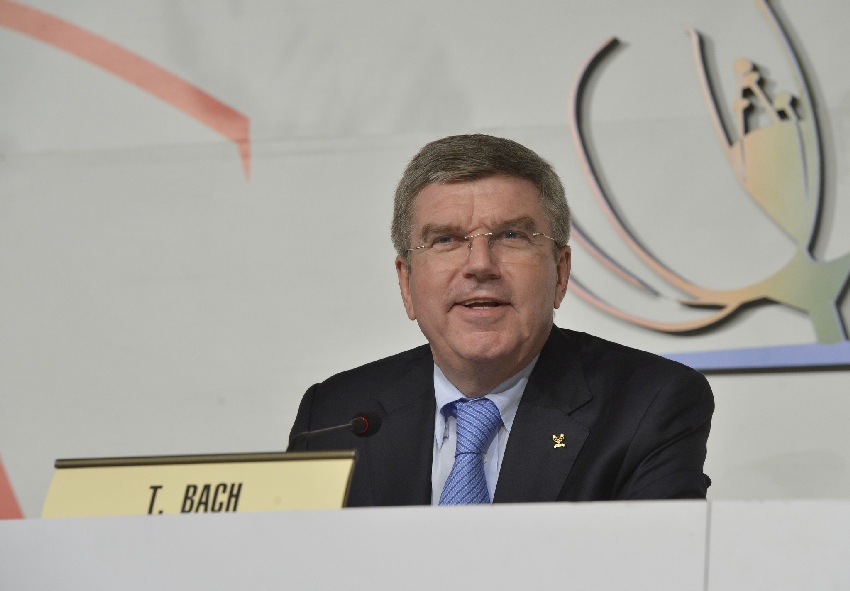 The Executive Board (EB) of the International Olympic Committee (IOC) today approved the event programme for the Olympic Games Tokyo 2020. The decision marks a key milestone in the evolution of the Olympic programme by introducing youth and urban innovations, significantly improving gender equality, and reducing the overall number of athletes hence reducing the Games’ footprint.
The Executive Board (EB) of the International Olympic Committee (IOC) today approved the event programme for the Olympic Games Tokyo 2020. The decision marks a key milestone in the evolution of the Olympic programme by introducing youth and urban innovations, significantly improving gender equality, and reducing the overall number of athletes hence reducing the Games’ footprint.
Commenting on the decision, IOC President Thomas Bach said “The fascinating new events that we approved today, together with the five new sports that were added to the Tokyo 2020 programme last year, represent a step-change in the Olympic programme. I am delighted that the Olympic Games in Tokyo will be more youthful, more urban and will include more women”, Bach added.
The EB decision will lead to a net increase of 15 events, an overall reduction of 285 athletes from Rio 2016, and the highest representation of female athletes in Olympic history. In Tokyo, the number of mixed events will double from nine in Rio 2016 to 18. All new events will make use of existing venues.
Today’s decision is a significant step towards achieving the 50 per cent gender balance at the Olympic Games in both athletes and events, as clearly stated by Olympic Agenda 2020.
Four new International Federations (IFs) will move to gender-balanced in events for the first time (Canoe, Rowing, Shooting and Weightlifting). In terms of athletes, six IFs will move to gender balance for the first time (Canoe, Judo, Rowing, Sailing, Shooting and Weightlifting). At discipline level, gender balance is achieved in BMX Racing, Mountain Bike and Freestyle Wrestling.
The programme also includes youth-focused and urban-based additions such as Basketball 3x3 and BMX Freestyle, on top of Sport Climbing and Skateboarding. Basketball 3x3 was a successful innovation at the Youth Olympic Games in Singapore 2010 and Nanjing 2014. Sport Climbing and Skateboarding were proposed along with Baseball/Softball, Karate, and Surfing by Tokyo 2020 last year.
The next edition of the Summer Youth Olympic Games, which will take place in Buenos Aires in October 2018, will already feature BMX Freestyle, Karate and Sport Climbing as well as several new innovative urban sports such as Breakdance and Roller Sports.
The review process for the Tokyo 2020 programme started in Rio 2016, where comprehensive data were collected for the first time at event level, giving IFs unparallelled insight into the overall performance of their sports, disciplines and events at the Olympic Games. Concurrently, IFs were invited to submit their requests for changes to their events, athlete quotas and competition formats to the IOC by February 2017.
Having reviewed the proposals in full, the Olympic Programme Commission met on 5 May and made a number of recommendations to the IOC EB. Based on these recommendations, the EB took the following decision regarding new events in Tokyo:
|
EVENTS – Additions unless specified |
||
|
Events |
||
|
Sport |
Event |
# |
|
Aquatics (Swimming) |
800m (M) & 1500m (W) |
+2 |
|
4x100m Medley Mixed Relay |
+1 |
|
|
Archery |
Mixed Team Event |
+1 |
|
Athletics |
4x400m Mixed Relay |
+1 |
|
Basketball |
3x3 (M/W) |
+2 |
|
Boxing |
Transfer of two men's events to two women's events |
0 |
|
Canoe |
Transfer of three men's events to three women's events |
0 |
|
Cycling (BMX) |
BMX Freestyle Park (M/W) |
+2 |
|
Cycling (Track) |
Madison (M/W) |
+2 |
|
Fencing |
Team Events (M/W) |
+2 |
|
Judo |
Mixed Team Event |
+1 |
|
Rowing |
Transfer of one men's event to one women's event |
0 |
|
Sailing |
Transfer of Mixed Multihull to Mixed Foiling Multihull |
0 |
|
Shooting |
Transfer of three men's events to mixed events |
0 |
|
Table Tennis |
Mixed Doubles |
+1 |
|
Triathlon |
Mixed Team Relay |
+1 |
|
Weightlifting |
Reduction of one men’s weight category |
-1 |
|
TOTAL (net) |
+15 |
|
Tokyo 2020 was consulted throughout the process and gave its agreement on the principles applied to the review of all events. Together with the IOC, it was agreed that there should be minimal impact on additional venues and athletes, and on the overall competition schedule.
The EB today also approved the recommendations of the Programme Commission with regard to the athlete numbers by sport - as follows:
|
Athletes – Additions, transfers and reductions |
||
|
Athletes quotas |
||
|
Sport |
Event |
# |
|
Aquatics (Water Polo) |
Reduction in Water Polo team size, addition of two women’s Water Polo teams |
-18 |
|
Aquatics (Swimming) |
Reduction of 22 athletes |
-22 |
|
Athletics |
Reduction of 105 athletes |
-105 |
|
Basketball |
Inclusion of 3x3 with 8 teams for each gender, +64 athletes (32W/32M) |
+64 |
|
Boxing |
Transfer of 44 athletes from men to women |
0 |
|
Canoe |
Transfer of 55 athletes to reach gender balance |
0 |
|
Cycling (BMX Racing) |
Transfer of 8 athletes to reach gender balance |
0 |
|
Cycling (MTB) |
Transfer of 8 athletes to reach gender balance in MTB, transfer of 4 male athletes to BMX Freestyle |
0 |
|
Cycling (Road) |
Transfer of 14 men to BMX Freestyle |
0 |
|
Judo |
Transfer of 38 athletes to reach gender balance |
0 |
|
Rowing |
Reduction of 24 athletes and reach gender balance |
-24 |
|
Sailing |
Reduction of 30 athletes and reach gender balance |
-30 |
|
Shooting |
Reduction of 30 athletes and reach gender balance |
-30 |
|
Weightlifting |
Reduction of 64 athletes and reach gender balance |
-64 |
|
Wrestling |
Reduction of 56 athletes across all disciplines and gender balance in Freestyle Wrestling |
-56 |
|
TOTAL |
-285 |
|
Special accessibility plan for Cortina 2021 presented. Malagò: “an opportunity for the sport and for these valleys”
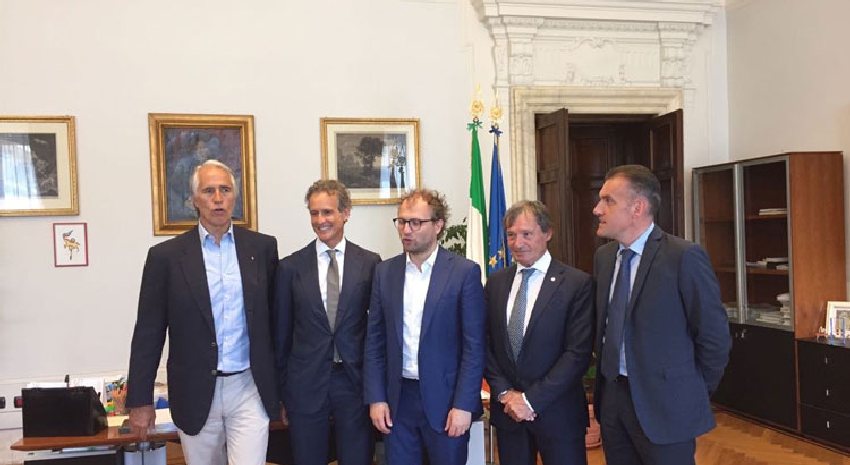 Improving accessibility with increased comfort and safety for drivers on trunk road 51 “di Alemagna” and trunk road 52 “Carnica”. These are the goals of the NARC Investment Plan for the Alpine World Ski Championships in Cortina in 2021. The plan, unveiled today by the President of NARC, Gianni Vittorio Armani, in the presence of Minister for Sport Luca Lotti, the Minister for Infrastructure and Transport, Graziano Delrio, the President of the Cortina 2021 Foundation, Alessandro Benetton, the President of the INOC, Giovanni Malagò, the President of the IWSF, Flavio Roda, involves a total investment of 242 million euros and is entirely funded by the NARC - Mit 2016-2020 Programme Contract for 142 million euros and by the Stability Act 2017, which authorised a total expenditure of 100 million euros (20 million/year from 2017 to 2021).
Improving accessibility with increased comfort and safety for drivers on trunk road 51 “di Alemagna” and trunk road 52 “Carnica”. These are the goals of the NARC Investment Plan for the Alpine World Ski Championships in Cortina in 2021. The plan, unveiled today by the President of NARC, Gianni Vittorio Armani, in the presence of Minister for Sport Luca Lotti, the Minister for Infrastructure and Transport, Graziano Delrio, the President of the Cortina 2021 Foundation, Alessandro Benetton, the President of the INOC, Giovanni Malagò, the President of the IWSF, Flavio Roda, involves a total investment of 242 million euros and is entirely funded by the NARC - Mit 2016-2020 Programme Contract for 142 million euros and by the Stability Act 2017, which authorised a total expenditure of 100 million euros (20 million/year from 2017 to 2021).
“The actions we have decided upon, for which planning is ongoing,” said Armani, “constitute a series of measures aimed at increasing the usability of the roads leading to Cortina in view of the increase of traffic flow for the world ski championships. The works are aimed at raising the overall level of service of the national road network in the province of Belluno, with the ultimate goal of offering greater fluidity of traffic, as well as increased levels of safety and comfort for drivers”. The complex process of drafting the plan, valued at €172 million for trunk road 51 “di Alemagna”, was accompanied by a continuous discussion with local authorities in the area to identify shared solutions, in order to increase the environmental sustainability of the road, aiming to promote the different built-up areas it crosses.
The solutions proposed will appear regularly along the stretch of road between Pian di Vedoia and the Cimabanche Pass, and aim to facilitate the creation of four branches going through the built-up areas (Tai di Cadore, Valle di Cadore, San Vito di Cadore and Zuell), worth about 30 million euros each, that will greatly improve traffic safety and the quality of the area. These will be local branches of the road in close proximity to the built-up areas that do not cut out the local attractions, but rather represent opportunities for promotion. In addition to the works planned for trunk road 51 “di Alemagna”, design possibilities are being evaluated by NARC, valued at 70 million euros, aimed at improving the technical functioning of trunk road 52 “Carnica”, which is an important part of the system of accessibility for Cortina d'Ampezzo.
“The Plan being presented”, said Minister Lotti, “is a fundamental part of the Cortina 2021 project, which aims to make it feasible and fully achievable to hold a very high-level championship in terms of safety and environmental protection. The alpine world ski championships can become a driving force for the economy and an engine of growth and promotion of the area”.
Minister Delrio stressed that the government wants to support the areas in question with dedicated resources and through NARC to ensure, “in constant dialogue with the local authorities, useful connections capable of handling a global event. Connections that will, of course, be an asset for all citizens and for the tourists that the area wishes to attract”. “Cortina is an important event, and we must bear in mind that if Cortina wins, the Veneto and the country win too. To be perfectly honest, we would prefer to be further along with the works, as we have experienced some delays. I therefore have two appeals to make: one is not to waste time, the second is that only together can we win. We must work hard to make this a great event and have the courage to dream”, said Alessandro Benetton, President of the Cortina 2021 Foundation.
President Malagò, after having underlined the fundamental role of the Italian Winter Sports Federation in mountain sports, added: “The world ski championships in Cortina 2021 are an opportunity to give a boost to the sport and to these valleys". Legislative Decree 50/2017 of last 24 April also nominated, for the construction of the Road system enhancement plan in preparation for the Cortina 2021 World Ski Championships, a representative for the Government Commissioner, namely the President of NARC, Gianni Vittorio Armani.
Raffaella Masciadri and Kelum Asanka Perera appointed President and Vice President of the Athletes' Commission
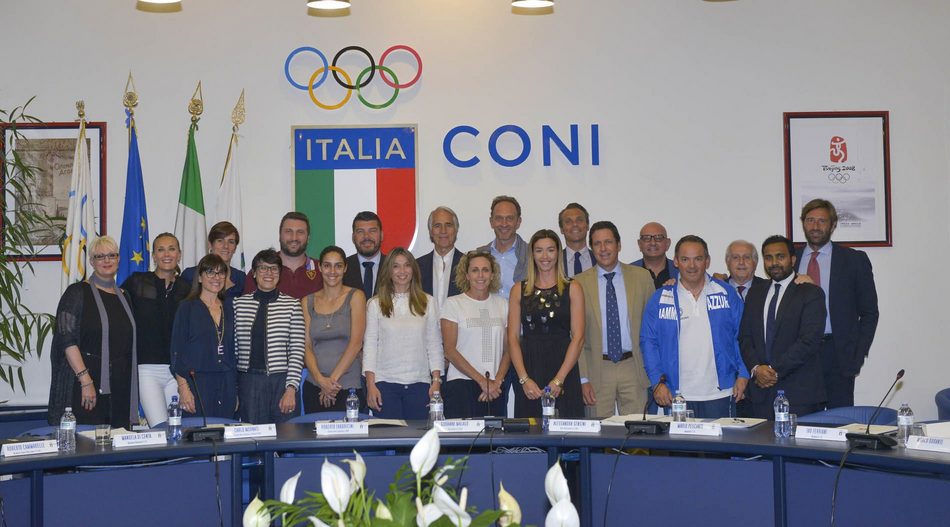 The National Athletes' Commission gathered today in the Sala Giunta to elect its highest authorities. The first official act of the new four-year turn has been attended by CONI's President Giovanni Malagò, General Secretary Roberto Fabbricini, Vice General Secretary and Olympic Preparation Manager Carlo Mornati, Vice President Alessandra Sensini along with IOC members Ivo Ferriani and Manuela Di Centa (honorary member), former President of the Athletes' Commission Marco Durante and former Vice President Raffaello Leonardo, who was yesterday appointed as President of NADO ITALIA's Drug Test Commission.
The National Athletes' Commission gathered today in the Sala Giunta to elect its highest authorities. The first official act of the new four-year turn has been attended by CONI's President Giovanni Malagò, General Secretary Roberto Fabbricini, Vice General Secretary and Olympic Preparation Manager Carlo Mornati, Vice President Alessandra Sensini along with IOC members Ivo Ferriani and Manuela Di Centa (honorary member), former President of the Athletes' Commission Marco Durante and former Vice President Raffaello Leonardo, who was yesterday appointed as President of NADO ITALIA's Drug Test Commission. Page 61 of 128


